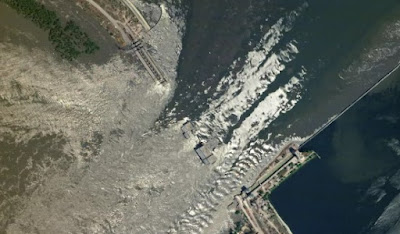Satellite images and maps of water spilling over the Kakhovka dam in Ukraine.
Ukraine has accused Russian forces of blowing up the Kakhovka dam in a Russian-controlled area on the front lines of the war, threatening hundreds of thousands of people across the region and potentially endangering Europe's largest nuclear power plant. See Ukraine map of power plants.
The Kakhovka Dam, also known as the Kakhovka Hydroelectric Power Plant, is a large dam and hydroelectric power station located on the Dnieper River in Ukraine. It is situated near the city of Kakhovka in the Kherson Oblast. Residents of the flooded Korabel district in Kherson are trying to save their and their neighbors' animals from flooding caused by the destruction of the Kakhovka hydroelectric power plant.
Here are some key facts about the Kakhovka Dam and another post we warned about earlier this year Russian military threat to Ukraine's nuclear reactors and facilities:
Where is the dam: The Kakhovka Hydroelectric Power Plant is in the city of Nova Kakhovka in Ukraine's Kherson region, which is currently under Russian occupation.
Construction: The dam was constructed between 1950 and 1956 as part of the Dnieper Hydroelectric Station complex, which includes several other dams and power plants along the Dnieper River.
Purpose: The primary purpose of the Kakhovka Dam is hydroelectric power generation. It harnesses the water flow from the Dnieper River to produce electricity.
Power Generation: The Kakhovka Hydroelectric Power Plant has a total installed capacity of 1,524 megawatts (MW) and consists of ten generating units. It is one of the largest hydroelectric power plants in Ukraine.
Reservoir: The dam forms the Kakhovka Reservoir, which is a large artificial lake created by the impoundment of water behind the dam. The reservoir has a surface area of about 2,155 square kilometers and a maximum depth of 25 meters.
Size: It's huge - locals call it the Kakhovka Sea as you cannot see the other bank in certain places. The dam holds water equal to the Great Salt Lake in the US state of Utah, according to Reuters.
Irrigation: In addition to power generation, the Kakhovka Dam and Reservoir also serve an important role in irrigation. Water released from the reservoir is used to irrigate agricultural lands in the surrounding areas.
Navigation: The dam has a lock system that allows ships and boats to navigate the Dnieper River. This helps facilitate transportation and trade along the river.
The Kakhovka Dam has played a significant role in Ukraine's energy infrastructure and has contributed to the country's power generation capacity. It provides electricity to the grid, supports irrigation for agriculture, and aids in river transportation.
What happened: Stills and video show a massive breach in the dam, with water surging through it and flooding downstream in the direction of Kherson. It's unclear when exactly the dam was first damaged, but satellite images suggest its condition has deteriorated over a number of days.
A road across the dam appears to be damaged since 2 June, but there does not seem to be a change to the flow of the water until 6 June when the breach of the wall and collapse of nearby buildings can be clearly seen. It is currently unclear whether the damage to the road is linked to the 6 June breach.
Here is an update from Tucker Carlson on this issue.
Ep. 1 pic.twitter.com/O7CdPjF830
— Tucker Carlson (@TuckerCarlson) June 6, 2023


